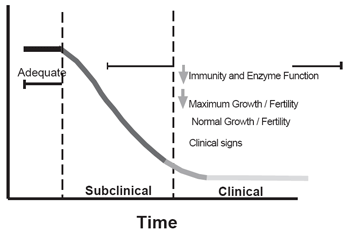Don't let mineral/vitamin deficiencies silently steal your profits
Published: July 23, 2008
Source : Montana State University Extension Service
Macrominerals are nutrients required daily in large amounts (grams) and include calcium (Ca), chlorine (Cl), magnesium (Mg), phosphorous (P), potassium (K), sodium (Na) and sulfur (S). Microminerals or trace minerals are nutrients required daily in small amounts (milligrams) and include: cobalt (Co), copper (Cu), iodine (I), iron (Fe), manganese (Mn), molybdenum (Mo), selenium (Se) and zinc (Zn). Some elements such as chromium (Cr) and nickel (Ni) may be required in ultra-trace amounts (micrograms). The most necessary vitamin supplements required for ruminants are the fatsoluble vitamins A and E. The fat-soluble vitamin K and water-soluble B vitamins are abundant in many feeds and are synthesized by ruminal microorganisms. Therefore, their supplementation is generally not required.
When selecting a commercially manufactured supplement mix, it is important to note not only the concentration of minerals, but also their source. Mineral sources vary in bioavailability, or how much of the mineral can be absorbed and utilized. For example, copper sulfate is well utilized by cattle, whereas copper oxide has nearly zero availability. Be sure to read feed tags carefully. Cost should not be the sole consideration.
Vitamins in a mineral-vitamin supplement will lose their potency over time. For this reason, it is important to keep mineral-vitamin supplements fresh, cool, dry and out of direct sunlight. Only purchase or mix as much supplement as can be consumed in a 60- to 90-day period. You may want to check with your feed manufacturer to verify the date on which the supplement was made. Vitamin A and E are high in fresh forages and are relatively expensive ingredients in the mix. Excluding these vitamins from a supplement fed to cattle grazing fresh forages may help reduce the cost of supplementation. It is imperative, though, that these vitamins are supplemented to cattle receiving harvested forages.
Record the amount and date of mineral feeding so consumption can be monitored. Underconsumption may negate the benefits of mineral supplementation. Some producers have indicated that consumption of mineral-vitamin mixes falls to extremely low levels during certain times of the year. This is often a result of the mineral mix getting wet, caking and becoming hard. Another factor that may contribute to a low consumption rate is magnesium oxide, which is an unpalatable ingredient. This can be somewhat overridden by a sweetening agent.

Figure 1. Changes in trace mineral status and proposed effects on immunity and performance.
Consumption also rises and falls during periods of the production cycle. Generally, consumption is higher in spring and early summer with succulent forage, and during peak lactation. Consumption declines later in the pasture season and after calves are weaned. In some areas, salty or "brackish" water will reduce mineral consumption. If self-fed mineral mixes are to be used, this should be the only source of salt available. If consumption becomes a problem, it may be necessary to increase the amount of sweetening or flavoring agents.
Location and design of feeders are important to maintain consistent mineral-vitamin mix consumption. Place feeders in areas that cattle frequent, such as near water, loafing areas, back rubbers, etc. It is important to keep the mix in a well-constructed self-feeder that limits precipitation or in a sheltered trough. Watch for caking, mold, manure and other contamination. Cattle licking and salivating on the mix may also cause caking. Therefore, keep the mix fresh and do not feed too much at one time. However, keep mineral in the feeder at all times to encourage steady consumption.
Mineral and vitamin supplementation should be carefully balanced. Provision of a particular mineral, because of its attributes, in gross excess of requirements will likely be detrimental to absorption of other minerals. This, in turn, may cause a deficiency of other minerals. In general, over-consumption will unduly increase supplementation costs and can also cause possible environmental problems associated with runoff from animal waste or manure application to soil. You may expect over-consumption for a few weeks if cattle have been mineral-deficient for a period of time. However, cattle may over-consume mineral if it is appetizing and eat much more than their nutrient requirements.
In some cases, organic elemental complexes (organics or chelates) may have higher rates of absorption compared to ionic elemental forms (inorganic). However, the potential benefit of organic mineral sources needs to justify their additional cost.
If you are unsure if your mineral mix is meeting your animals' requirements, contact your local Extension agent or beef specialist for assistance.
By Dan Buskirk, Gretchen Hill and Harlan Ritchie, Department of Animal Science, Michigan State University
Published on "Beef: Questions & Answers" newsletter - Montana State University Extension Service
Source
Montana State University Extension ServiceRelated topics:
Recommend
Comment
Share

Would you like to discuss another topic? Create a new post to engage with experts in the community.




